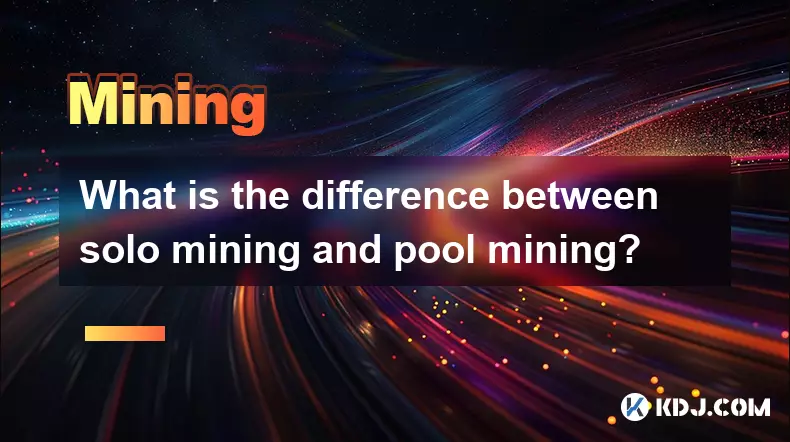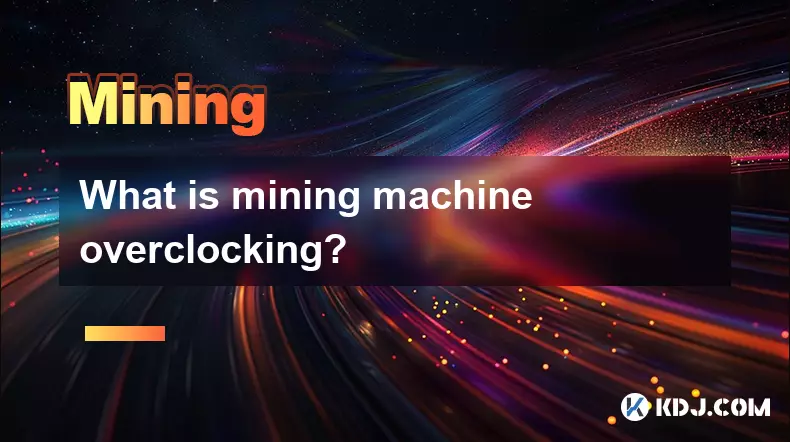-
 bitcoin
bitcoin $109547.008142 USD
0.04% -
 ethereum
ethereum $4011.838726 USD
-0.05% -
 tether
tether $1.000402 USD
-0.01% -
 xrp
xrp $2.798606 USD
0.88% -
 bnb
bnb $970.877944 USD
1.39% -
 solana
solana $202.237275 USD
-0.95% -
 usd-coin
usd-coin $0.999673 USD
0.00% -
 dogecoin
dogecoin $0.229294 USD
-1.15% -
 tron
tron $0.336370 USD
-0.45% -
 cardano
cardano $0.777260 USD
-1.66% -
 hyperliquid
hyperliquid $45.503019 USD
1.73% -
 ethena-usde
ethena-usde $1.000362 USD
0.01% -
 chainlink
chainlink $20.785303 USD
-1.10% -
 avalanche
avalanche $28.755822 USD
-0.11% -
 stellar
stellar $0.358303 USD
-0.48%
What is the difference between solo mining and pool mining?
Solo mining offers full block rewards but requires massive computational power and faces high variance, making it challenging for small-scale miners.
Sep 15, 2025 at 07:36 pm

Solo Mining Explained
1. Solo mining refers to the process where an individual miner uses their own computational resources to solve cryptographic puzzles and validate transactions on a blockchain network. The miner operates independently without joining any collective group. Every block found belongs entirely to the miner if successfully mined.
2. The primary appeal of solo mining lies in the full reward ownership. When a miner finds a block, they receive 100% of the block reward and transaction fees without sharing with others. This model suits those who value autonomy and complete control over their mining output.
3. However, solo mining demands substantial computing power. The probability of finding a block is directly tied to the miner's hash rate relative to the total network hash rate. With increasing network difficulty, individual miners often face long intervals between successful blocks, sometimes months or even years.
4. Equipment and electricity costs can outweigh rewards in solo mining, especially for smaller setups. Miners must maintain high uptime and efficient hardware to remain competitive. Profitability is highly unpredictable and depends heavily on luck and network conditions.
5. Solo mining offers full rewards but comes with high variance and requires significant investment in hardware and energy.
Pool Mining Dynamics
1. Pool mining involves multiple miners combining their computational power to increase the collective chance of solving blocks. When a block is found by any member of the pool, the reward is distributed among participants based on their contributed hash rate.
2. This method reduces the variance in income. Instead of waiting indefinitely for a single large payout, miners receive smaller but more frequent payments. The consistency makes pool mining attractive for those seeking stable returns.
3. Mining pools charge a fee, typically between 1% and 3%, for managing operations, coordinating efforts, and distributing rewards. Some pools use different reward systems like PPLNS (Pay Per Last N Shares) or proportional models to ensure fairness.
4. Joining a pool lowers the barrier to entry. Miners with modest setups can participate and earn rewards that would be nearly impossible through solo mining. The shared infrastructure also reduces individual operational complexity.
5. Pool mining provides steady income through collaboration, making it ideal for miners with limited resources or those prioritizing reliability over full block ownership.
Risks and Considerations
1. Centralization concerns arise with pool mining. A few large pools can accumulate significant hash power, potentially threatening network decentralization. If a single pool controls more than 50% of the network hash rate, it could theoretically execute a 51% attack.
2. Solo miners face the risk of prolonged unprofitability. Even with powerful rigs, the randomness of block discovery means extended dry spells are common. This unpredictability can discourage long-term participation without deep financial reserves.
3. Pools may impose withdrawal thresholds or delayed payments, affecting cash flow. Some pools have been known to shut down unexpectedly, risking loss of accumulated balances if proper safeguards aren’t in place.
4. Network difficulty adjustments impact both models differently. Solo miners may see their already slim chances shrink during periods of rapid hash rate growth, while pools adapt more smoothly due to aggregated power.
5. Both methods carry unique risks—centralization for pools and high variance for solo mining—requiring careful evaluation based on individual goals and resources.
Common Questions
What determines profitability in solo mining?Profitability depends on hash rate, electricity cost, hardware efficiency, and network difficulty. A miner must calculate whether the expected time to find a block justifies ongoing operational expenses.
How are rewards distributed in a mining pool?Rewards are allocated based on each miner’s contribution to the total pool hash rate. Shares submitted by miners serve as proof of work, and payouts follow predefined schemes like PPLNS or proportional distribution.
Can small miners succeed in solo mining?Success is statistically unlikely for small miners due to low hash rate contribution. The probability of finding a block becomes negligible compared to large-scale operations or pools.
Is pool hopping a viable strategy?Pool hopping involves switching pools to maximize rewards under certain payout systems. While technically possible, its effectiveness has diminished as pools refined their reward algorithms to discourage exploitation.
Disclaimer:info@kdj.com
The information provided is not trading advice. kdj.com does not assume any responsibility for any investments made based on the information provided in this article. Cryptocurrencies are highly volatile and it is highly recommended that you invest with caution after thorough research!
If you believe that the content used on this website infringes your copyright, please contact us immediately (info@kdj.com) and we will delete it promptly.
- Snorter Bot: Your Ticket to 100x Crypto Presale Gems?
- 2025-09-29 06:25:16
- XRP Payments, Daily Wages, and Ripple Chief: A Revolution in Payroll?
- 2025-09-29 06:25:16
- XRP, Ripple, and the SWIFT Payments Revolution: A New Era?
- 2025-09-29 06:30:01
- RedotPay, Stablecoin, and Investment: A New Era of Digital Finance?
- 2025-09-29 06:30:01
- MoonBull: The Crypto to Watch in Q4 2025 for APY Rewards
- 2025-09-29 06:30:01
- MoonBull Presale: The Meme Coin Opportunity You Can't Miss (NY Edition)
- 2025-09-29 06:30:12
Related knowledge

The difference between staking and mining
Sep 24,2025 at 05:18am
Understanding Staking in the Cryptocurrency Ecosystem1. Staking involves holding funds in a cryptocurrency wallet to support the operations of a block...

How to participate in testnet mining?
Sep 22,2025 at 09:18am
Understanding Testnet Mining in the Crypto Ecosystem1. Testnet mining is a method used by blockchain developers to simulate real-world conditions on a...

How to dispose of abandoned mining machines?
Sep 19,2025 at 08:19pm
Assessing the Condition of Abandoned Mining Rigs1. Begin by inspecting each mining machine for visible damage, corrosion, or missing components. Machi...

How to identify high-quality mining pools?
Sep 21,2025 at 03:19pm
Reputation and Track Record1. A mining pool’s reputation is built over time through consistent performance and transparency. Pools that have operated ...

Advantages of decentralized mining pools
Sep 20,2025 at 04:36pm
Enhanced Security and Resistance to Censorship1. Decentralized mining pools operate on blockchain-based smart contracts, eliminating the need for a ce...

What is mining machine overclocking?
Sep 21,2025 at 07:19pm
Understanding Mining Machine Overclocking1. Mining machine overclocking refers to the process of increasing the operating frequency of a cryptocurrenc...

The difference between staking and mining
Sep 24,2025 at 05:18am
Understanding Staking in the Cryptocurrency Ecosystem1. Staking involves holding funds in a cryptocurrency wallet to support the operations of a block...

How to participate in testnet mining?
Sep 22,2025 at 09:18am
Understanding Testnet Mining in the Crypto Ecosystem1. Testnet mining is a method used by blockchain developers to simulate real-world conditions on a...

How to dispose of abandoned mining machines?
Sep 19,2025 at 08:19pm
Assessing the Condition of Abandoned Mining Rigs1. Begin by inspecting each mining machine for visible damage, corrosion, or missing components. Machi...

How to identify high-quality mining pools?
Sep 21,2025 at 03:19pm
Reputation and Track Record1. A mining pool’s reputation is built over time through consistent performance and transparency. Pools that have operated ...

Advantages of decentralized mining pools
Sep 20,2025 at 04:36pm
Enhanced Security and Resistance to Censorship1. Decentralized mining pools operate on blockchain-based smart contracts, eliminating the need for a ce...

What is mining machine overclocking?
Sep 21,2025 at 07:19pm
Understanding Mining Machine Overclocking1. Mining machine overclocking refers to the process of increasing the operating frequency of a cryptocurrenc...
See all articles










































































